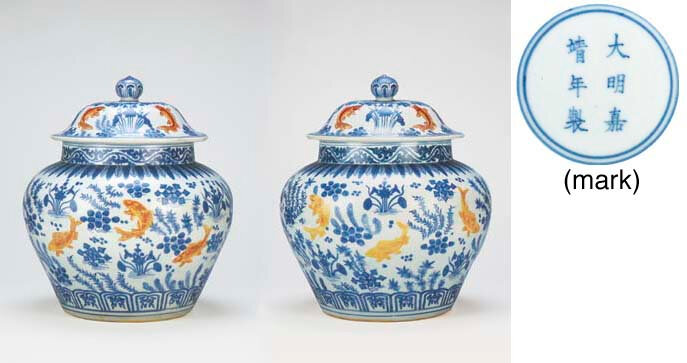A very rare enamelled blue and white 'fish' jar and cover, Jiajing six-character mark and of the period (1522-1566)
Lot 79. A very rare enamelled blue and white 'fish' jar and cover, Underglaze-blue Jiajing six-character mark within a double circle and of the period (1522-1566); 15 5/8 in. (39.8 cm.) high. Estimate GBP 120,000 - GBP 150,000. Price realised GBP 248,650. © Christie's Images Ltd 2002.
Painted in bright blue tones with stylised lotus panels around the foot and a band of plantain leaves beneath a classic scroll around the neck, with eight carp in yellow enamel overlaid with iron-red details leaping and swimming amidst clumps of luxuriant aquatic weeds, polyps and lotus sprays,the domed cover similarly painted and surmounted by a bud-shaped finial, section of neck and cover rim chips and glaze chip on bud finial restored.
Provenance: Christie's, Hong Kong, 29 September 1992, lot 484.
Note: This rare and beautiful vessel belongs to a small group of lidded jars depicting fish in a lotus pond, which are decorated with underglaze cobalt blue aquatic plants and borders, and overglaze enamel fish. These jars, dating to the Jiajing reign, provide an interesting comparison to the well-known wucai fish jars. The type represented by the current example is, in fact, rarer and is distinguished by the fine quality of the painting and the liveliness of the fish. The subject is of course an especially auspicious one. The Chinese for lotus is either he hua, providing a rebus for 'harmony', or lian hua, suggesting 'continuity'. The word for fish in Chinese, yu, provides a rebus for 'abundance'. Golden fish, like the carp on this jar and cover, suggest an abundance of gold. A school of gold fish swimming in a pond (tang in Chinese) provide a rebus for the phrase jinyu mantang, offering a wish that the household will be filled with gold and jade.
The ceramic decorators skilfully used the cobalt pigment to indicate the different textures of the flowering lotus, water-weed, and other aquatic plants. The result is a design of much greater delicacy and complexity than that seen on the traditional wucai examples. The twelve fish depicted on the jar and its cover provide a most effective visual contrast to the blue decoration. They are shown vigorously leaping and diving, and the colour of the fish is vibrantly evoked using the technique of painting their silhouette in yellow enamel, providing colour gradation using iron-red washes, and then drawing outlines and details in fine iron-red. Although a similar technique is used to that on the wucai jars, the fish on the current jar are much more finely and realistically rendered.
A Jiajing period jar and cover, similar to the current vessel, from the Qing court collection is in the Palace Museum, Beijing (The Complete Collection of Treasures of the Palace Museum - 35 - Blue and White Porcelain with Underglaze Red II, Commercial Press, Hong Kong, 2000, p. 251, no. 227). A further jar and cover in the collection of the Victoria and Albert Museum is illustrated by R. Kerr, et al., in Chinese Art and Design: The T.T. Tsui Gallery of Chinese Art, Victoria and Albert Museum, London, 1991, p. 166, colour pl. 72. A third jar and cover has been preserved in the collection of the Capital Museum, Beijing and is illustrated by Liu Liang-yu in A Survey of Chinese Ceramics - 4 - Ming Official Wares, Aries Gemini Publishing, Taipei, 1991, p. 215.
Porcelain jar with lid decorated with watery plants in underglaze cobalt blue and fishes in overglaze iron red, Ming dynasty, Jiajing reign (1522-66), Height: 73 cm, Diameter: 35 cm, Diameter: 12.5 cm baseHeight: 73 cm, Diameter: 35 cm, Diameter: 12.5 cm base, Museum no. Circ.118-1936. From the Eumorfopoulos collection, purchased with the assistance of The Art Fund, the Vallentin Bequest, Sir Percival David and the Universities China Committee [Art Fund logo] [2007]. © Victoria and Albert Museum, London
Four jars of this type without lids have been published. One is in the Asian Art Museum of San Francisco, He Li, Chinese Ceramics - The New Standard Guide, Thames and Hudson, London, 1996, p. 231, no. 453. Another is published in Mayuyama, Seventy Years, Vol. 1, Mayuyama & Co, Tokyo 1976, p. 281, no. 843. A third, from a private collection, is illustrated by R. Fujioka and G. Hasebe (eds.), in Sekai Toji Zenshu, 14, Ming, Shogakukan, Tokyo, 1976, pp 72-3, no. 74. The fourth was included in the Exhibition of Chinese Ceramics from Neolithic Age to Qing Dynasty, Museum of Oriental Ceramics, Osaka, 1986, p. 24, no. 678.
Christie's. Chinese Ceramics & Chinese Export Ceramics & Works of Art, London, 12 November 2002

/https%3A%2F%2Fprofilepics.canalblog.com%2Fprofilepics%2F1%2F0%2F100183.jpg)
/https%3A%2F%2Fstorage.canalblog.com%2F03%2F02%2F119589%2F96711876_o.jpg)
/https%3A%2F%2Fstorage.canalblog.com%2F11%2F31%2F119589%2F94773502_o.jpg)
/https%3A%2F%2Fstorage.canalblog.com%2F20%2F83%2F119589%2F94772815_o.jpg)
/https%3A%2F%2Fstorage.canalblog.com%2F26%2F72%2F119589%2F75604929_o.jpg)
/https%3A%2F%2Fstorage.canalblog.com%2F59%2F60%2F119589%2F26458628_o.jpg)





/image%2F1371349%2F20240413%2Fob_120396_2024-nyr-22642-0941-001-an-exceptional.jpg)
/http%3A%2F%2Fstorage.canalblog.com%2F75%2F48%2F119589%2F129232288_o.png)
/http%3A%2F%2Fstorage.canalblog.com%2F74%2F26%2F119589%2F129194235_o.jpg)
/http%3A%2F%2Fstorage.canalblog.com%2F65%2F90%2F119589%2F128673430_o.jpg)